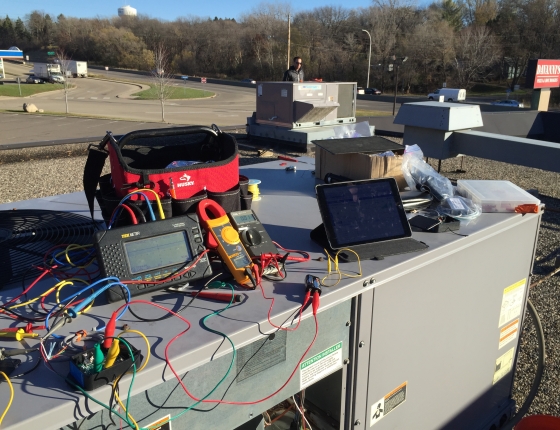Objective
Packaged roof-top units (RTUs) are ubiquitous on commercial buildings throughout the United States because of their low capital cost, reliability, and well-developed service and distribution network. There is anecdotal evidence, however, that these systems tend to operate inefficiently and sub-optimally. To validate or refute this evidence, the project team conducted a multilevel field study to characterize both new and existing RTUs in Minnesota and monitor the energy performance of existing RTUs.
Methodology
The first stage of this project, conducted by Seventhwave, characterized both existing RTUs and the new/replacement market. The project team collected building-level and existing RTU data for 101 surveyed buildings and analyzed the new and replacement market for RTUs in Minnesota.
CEE conducted the second stage of the project, which monitored existing RTU energy performance. The team recruited buildings for RTU monitoring from those identified in the characterization study. Twenty agreed to an in-depth site visit aimed at identifying RTUs that could be monitored for a six- to nine-month period. A total of 93 RTUs were assessed and, of those, 52 were monitored. The project team used the monitored data from the test sites to model RTU annual consumption and sizing. Based on these models, the required heating and cooling loads at design temperatures could be calculated and compared to the installed capacity of each RTU.
Results
Characterization
Existing RTUs
- There are currently 20,700 ±3,100 Minnesota buildings with RTUs. Approximately 80% of commercial buildings are served by RTUs.
- There are approximately 136,000 ±30,000 existing RTUs in Minnesota. On average, commercial buildings served by RTUs have 6 to 7 RTUs on site.
- The average age of an existing RTU in Minnesota is 13.1 years.
- The total estimated cooling capacity of RTUs in Minnesota is roughly 1.3 million tons with an average of 10.7 tons per RTU. The average full-load cooling efficiency is 10.6 IEER while the average for part-load cooling efficiencies is 11.2.
- The total estimated heating capacity of RTUs in Minnesota is approximately 23.8 million MBH with an average of 205 MBH per RTU.
New/Replacement RTUs
- An estimated 6,400 RTUs are shipped to Minnesota commercial buildings annually.
- The estimated sales of RTUs in Minnesota is $88 million annually.
- Upgrading to high-performance RTUs would lead to a predicted electricity savings of 1,183 million kWh (4,037 million kBtu) and natural gas savings of 28 million therms (2,839 million kBtu), about $142 million in cost savings for Minnesota businesses.
Monitoring of Existing RTUs
Results from the monitoring phase of the project indicate that it is extremely difficult to predict RTU energy performance. The spaces conditioned by RTUs vary greatly from site to site, making it difficult to accurately predict annual energy consumption for an RTU. In addition, RTU performance is highly variable, and the factors impacting performance cannot be easily identified using traditional, straight-forward auditing techniques. While there are factors that may indicate high and low performance, in-depth assessments are needed to determine the cause of and solutions to poor performance in RTUs.
The sizing evaluation of RTUs at each site showed that RTUs are typically sized to meet the cooling needs of a site and this often leads to oversizing when it comes to heating, creating serious comfort issues for occupants. When a unit is oversized for heating, the space it serves can experience dramatic swings between hot and cold air; more efficient sizing could solve these types of problems.
CIP Recommendations
Expanding the Minnesota Technical Reference Manual (TRM) to include a wider scope of RTU-related measures will aid in the development of more comprehensive RTU programs. Other efficiency options that are now available and could be added to a comprehensive RTU program include:
- Demand control ventilation,
- Improved economizers,
- Casing insulation,
- Efficient supply fan,
- Condensing gas-fired heat exchanger,
- Energy recovery ventilation,
- Evaporative cooling retrofit packages, and
- Increasingly sophisticated and intelligent controls.
Utility rebates for RTUs have historically been based on exceeding a minimum level of efficiency, but only when at maximum energy usage. Since RTUs don't typically operate at maximum capacity around the clock, however, it is important to find efficiencies when energy use is lower too. Developing rebates based on the Integrated Energy Efficiency Ratio (IEER) — to account for efficiency when the energy load is less — would benefit utility programs whose priority is annual energy savings.
Project Summary
Objective
- Characterize RTUs installed on Minnesota buildings to better understand the market for new and replacement RTUs.
- Monitor energy use of RTUs to establish a baseline for development of effective utility programs for RTU optimization.
Scope
Monitor energy use and performance of 80 RTU units for 9-12 months.
Non-energy benefits
An energy efficiency program would also generate improved IAQ and occupant thermal comfort for many buildings.
Related Reports and Resources
